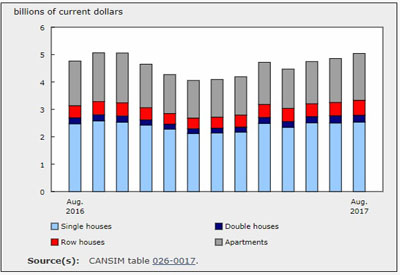New Housing Investment Grew 5.8% YOY in August

Oct 30, 2017
New housing construction investment rose 5.8% from August 2016 to $5.0 billion in August 2017, with gains reported for all building types.
Despite year-over-year declines in six provinces, single-family homes still led investment in new housing construction with total investment of $2.5 billion. Quebec (-$37.3 million) and Ontario (-$34.1 million) posted the largest declines for single-family homes, while Alberta (+$133.0 million) reported a seventh consecutive year-over-year increase.
The gap between investment in multiple-dwelling buildings (doubles, row homes and apartments) and single-family homes is continuously shrinking. In August 2007, investment in single-family homes almost doubled total investment in multiple-dwelling buildings. A decade later, in 2017, the difference was only 1.2%. During this 10-year period, the gap between investment in single homes and multiple-dwelling buildings narrowed in every province except New Brunswick.
Quebec posted the most significant change, with investment in single-family homes surpassing that of multiple-dwelling buildings in 2007, whereas in August 2017, the value for multiple-family dwellings ($462.8 million) more than doubled that of single-family homes ($230.5 million). This change in Quebec was driven by investment in apartment building construction.
Apartment building construction rose 5.2% from August 2016 to $1.7 billion in August. Seven provinces reported increased investment in apartment building construction, led by Quebec (+$72.0 million).
Investment in row homes posted the largest year-over-year increase (+$99.9 million) among all building types, bringing total spending for this building type to its highest value ($541.1 million) since January 1992, the year Statistics Canada started to produce data on investment in new housing construction.
Seven provinces reported year-over-year investment growth, with the largest upswing in Alberta. Manitoba and Prince Edward Island were the only two provinces with a year-over-year increase for all building types.
Source: Statistics Canada, http://www.statcan.gc.ca/daily-quotidien/171020/dq171020c-eng.htm




![Guide to the Canadian Electrical Code, Part 1[i] – A Road Map: Section 52 — Diagnostic imaging installations](https://electricalindustry.ca/wp-content/uploads/2022/11/Guide-CE-Code-2-768x432.png)





![Guide to the Canadian Electrical Code, Part 1[i] – A Road Map: Section 52 — Diagnostic imaging installations](https://electricalindustry.ca/wp-content/uploads/2022/11/Guide-CE-Code-2.png)






